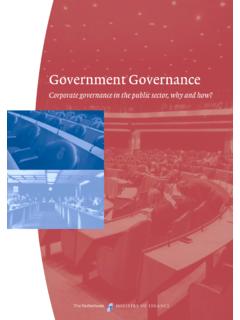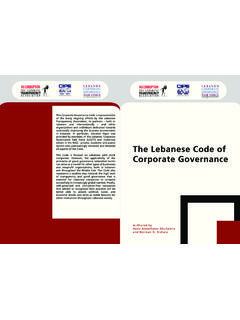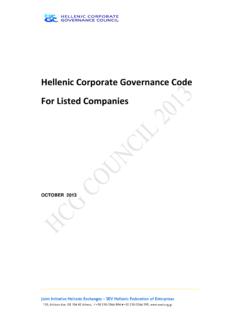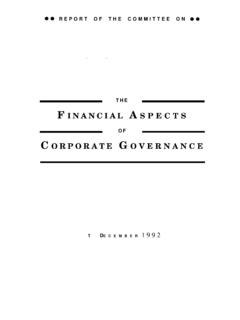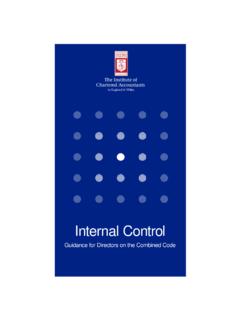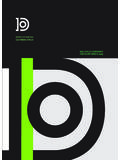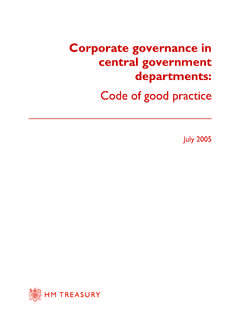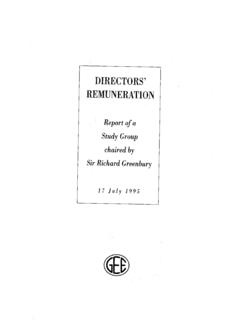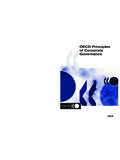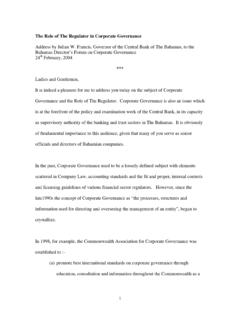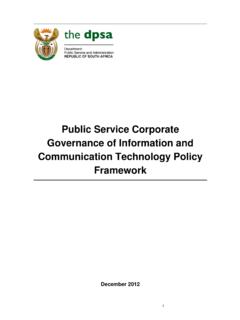Transcription of THE ROLE OF CORPORATE GOVERNANCE IN OSFI’S …
1 255 Albert Street Ottawa, Canada K1A 0H2 Guideline Subject: CORPORATE GOVERNANCE Category: Sound Business and Financial Practices Date: January 2013 I. Purpose and Scope of the Guideline The purpose of this guideline is to communicate OSFI s expectations with respect to CORPORATE GOVERNANCE of federally-regulated financial institutions (FRFIs). It applies to all FRFIs other than the branch operations of foreign banks and foreign insurance OSFI recognizes that FRFIs may have different CORPORATE GOVERNANCE practices depending on: their size; ownership structure; nature, scope and complexity of operations; CORPORATE strategy; and risk profile. This guideline complements: Relevant provisions of the Bank Act, the Insurance Companies Act, the Trust and Loan Companies Act, the Cooperative Credit Associations Act and associated regulations; and, OSFI s Supervisory Framework and Assessment Criteria.
2 Section II of the guideline describes the importance and uniqueness of sound CORPORATE GOVERNANCE for financial institutions. Sections III, IV and V, respectively, focus on three fundamental components of CORPORATE GOVERNANCE for FRFIs: The role of the Board of Directors (Board);2 Risk GOVERNANCE ; and The role of the Audit Committee. 1 Branches do not have Boards of Directors and, accordingly, it would be inappropriate to apply the specific provisions of this guideline directly to branch operations. OSFI looks to the Chief Agent or Principal Officer of a branch to oversee the management of the branch, including matters of CORPORATE GOVERNANCE . These individuals are recognized as having overall responsibility for their respective branches and, therefore, should be aware of this guidance.
3 The Chief Agent and/or Principal Officer of branches should refer to Guideline E-4A and Guideline E-4B, as appropriate. 2 In this document, the term Board refers to either the entire Board or a committee of the Board that has been delegated a particular element of Board oversight. Banks/BHC/T&L/Co-op/Life/Frat/P&C/IHC CORPORATE GOVERNANCE January 2013 Page 2 of 18 Finally, Section VI discusses the critical role of CORPORATE GOVERNANCE in the supervisory process and OSFI s supervisory assessment. OSFI expects Boards and Senior Management of FRFIs to be proactive, and to be aware of best practices related to CORPORATE GOVERNANCE that are applicable to their institution. Where appropriate, FRFIs should adopt these best practices. II.
4 CORPORATE GOVERNANCE for FRFIs Defining CORPORATE GOVERNANCE The Organization for Economic Cooperation and Development (OECD) defines CORPORATE GOVERNANCE as: a set of relationships between a company s management, its board, its shareholders, and other stakeholders. CORPORATE GOVERNANCE also provides the structure through which the objectives of the company are set, and the means of attaining those objectives and monitoring performance are determined. Good CORPORATE GOVERNANCE should provide proper incentives for the board and management to pursue objectives that are in the interests of the company and its shareholders and should facilitate effective monitoring. 3 Appropriate organizational structures, policies and other controls help promote, but do not ensure, good CORPORATE GOVERNANCE .
5 GOVERNANCE lapses can still occur through undesirable behaviour and CORPORATE values. Effective CORPORATE GOVERNANCE is not only the result of hard structural elements, but also soft behavioural factors driven by dedicated directors and management performing faithfully their duty of care to the institution. What makes organizational structures and policies effective, in practice, are knowledgeable and competent individuals with a clear understanding of their role and a strong commitment to carrying out their respective responsibilities. The Board, Senior Management and the Oversight Functions4 A FRFI s Board and Senior Management are ultimately accountable for the FRFI s safety and soundness, and its compliance with governing legislation.
6 In this guideline, the roles of the Board and Senior Management are highlighted. The Board is responsible for providing stewardship, including direction-setting and general oversight of the management and operations of the entire FRFI. Senior Management is accountable for implementing the Board s decisions, and is responsible for directing and overseeing the operations of the FRFI. This distinction in the responsibilities between the Board and Senior Management is critical. In carrying out its responsibilities, Senior Management may delegate some of its responsibilities to the FRFI s oversight functions. The oversight functions are responsible for providing enterprise-wide oversight of operational 3 See OECD Principles of CORPORATE GOVERNANCE , revised in April 2004.
7 4 For the purpose of this guideline, the oversight functions include: Financial; Risk Management; Compliance; Internal Audit; and Actuarial. Banks/BHC/T&L/Co-op/Life/Frat/P&C/IHC CORPORATE GOVERNANCE January 2013 Page 3 of 18 The composition of the Senior Management of a FRFI will vary from institution to institution. Senior Management is composed of the Chief Executive Officer (CEO) and individuals who are directly accountable to the CEO. In addition to the CEO s direct reports, such as the heads of major business platforms or units, Senior Management may also include the executives responsible for the oversight functions, such as the Chief Financial Officer (CFO), Chief Risk Officer (CRO), Chief Compliance Officer (CCO), Chief Internal Auditor, and Chief Actuary (CA)6.
8 The Uniqueness of Financial Institutions The quality of FRFI CORPORATE GOVERNANCE practices is an important factor in maintaining the confidence of depositors and policyholders, as well as overall market confidence. This guideline, therefore, draws attention to specific areas of CORPORATE GOVERNANCE that are especially important for financial institutions ( , risk GOVERNANCE ), owing to the unique nature and circumstances of financial institutions and risks assumed relative to other corporations. See Annex A for a description of the special nature of financial institutions. III. The Role of the Board of Directors The Board plays a pivotal role in the success of a FRFI through the approval of the FRFI s overall strategy and risk appetite, and its oversight of the FRFI s Senior Management and internal controls.
9 Board Responsibilities In addition to the roles and responsibilities of the Board outlined in federal legislation, the Board should discharge, at a minimum, the following essential duties: 1.) Approve the FRFI s: Short-term and long-term enterprise-wide business objectives, strategy and plans (capital, financial, liquidity), including the Risk Appetite Significant strategic initiatives or transactions, such as mergers and acquisitions; Internal control framework; Appointment, performance review and compensation of the CEO and, where appropriate, other members of Senior Management, including the heads of the oversight functions; 5 As defined in OSFI s Supervisory Framework, operational management is responsible for planning, directing and controlling the day-to-day operations of a FRFI.
10 The oversight functions are independent of operational management. 6 The Chief Actuary is frequently the head of the Actuarial function, although in some circumstances it may be the Appointed Actuary. Note that the role of the head of the Actuarial function would generally include responsibilities beyond the legal requirements of the Appointed Actuary. 7 Refer to Annex B for a description of the Risk Appetite Framework. Banks/BHC/T&L/Co-op/Life/Frat/P&C/IHC CORPORATE GOVERNANCE January 2013 Page 4 of 18 Succession plans with respect to the Board, CEO and, where appropriate, other members of Senior Management, including the heads of the oversight functions; Mandate, resources and budgets for the oversight functions; and External audit plan, including audit fees and the scope of the audit engagement.
